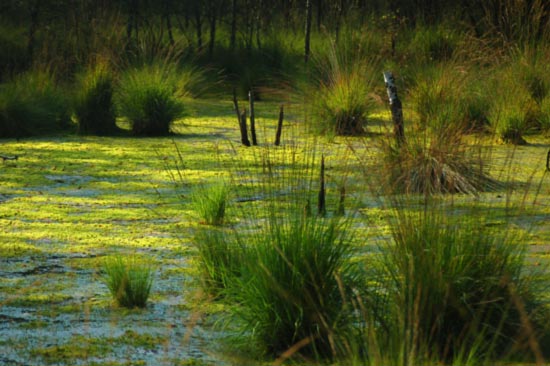What Is a Bog And How Is It Formed

Conjuring up images of dark, mossy wetlands that lure unsuspecting travellers to their deaths, and are inhabited by sinister creatures like ghouls and goblins, bogs generally tend to have all sorts of negative connotations. However, they are common and perfectly normal features of the environment around the world, and despite begin unsightly and often rank, can be highly beneficial in certain ways.
Instructions
-
1
A bog is, simply put, a wetland comprising of highly acidic water, covered by a thick mat of partially decomposed plant material, also known as peat. This nutrient poor acidic wetland is generally an inhospitable environment for most plant and animal life, but sphagnum moss, wildflowers, heath plants, turtles, insects, and carnivorous plants that prey on insects thrive in bogs, as do certain types of berries like cranberries, huckleberries, cloudberries, and lingonberries. Bogs are present all around the world, but tend to be more common in certain regions of the Northern Hemisphere.
-
2
Bogs are formed from slow-moving rivers or ponds, or near the edges of ponds and lakes that are gradually filling in with sediment – they tend to develop in colder weather, which promotes bog formation. These areas gradually become waterlogged and are taken over by sphagnum moss. This moss tends to decay slowly, and over time, forms a fibrous layer over the top, known as peat. New plants take root on this layer, then slowly decay and become part of the layer of peat. This layer of moss blocks sunlight and stifles oxygen and nitrogen supply to the water below, thus turning the water acidic – in addition, the decaying vegetation also releases its own organic acids into the water. Bogs generally tend to have poor drainage, and have no supply of fresh water save rainwater.
-
3
A unique ecosystem in its own right, a bog has several benefits. It can serve as a buffer zone which works to prevent flooding in certain areas, and has also provided human beings a source of fuel for thousands of years – in many areas, particularly countries like Ireland, Scotland and Wales, workers cut the peat out of bogs in the shape of bricks, dry it in the sun, and then use it for fuel as needed. Another benefit is available in the form of a phenomenon known as “bog bodies” – objects and bodies that get buried in bogs tend to decompose at an incredibly slow rate, and over time, have provided archaeologists and anthropologists plenty of objects for study, including ancient books, and mummified people like the Tollund Man.
-
4
However, while they might have advantages, bogs can be fairly dangerous. They tend to look solid, owing to the thick carpet of growing moss over the top, but this can easily be penetrated to reach the watery mass below, which can, in some cases, be more than 60 feet deep. Bogs generally contain only 2 to 10 percent solid peat, and 90 to 98 percent water.




